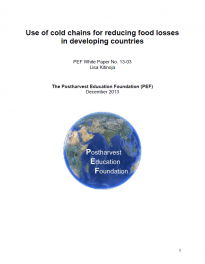Supportive Policy Environment for Cold Storage
Policy should aim to create an environment that enables the uptake of technology, good practices, and improve access to infrastructure, services, and markets that minimize food loss and waste (FLW). According to the 2017 Global Agriculture Productivity Report, reducing loss and waste on a wide scale is dependent largely on government investments in public goods, such as infrastructure. An enabling policy environment that supports private-sector innovation in harvest and storage technologies and stimulates behaviour change by consumers is also vital.
Introducing cold chain/cold storage in a developing country context requires the integration of a great many different elements and the continuing management of those elements. Policy makers in the agriculture, energy, education and food sectors must work together to promote the use of cold chain technology, improve logistics, maintenance, services, infrastructure, education and management skills, and create sustainable markets for the design, use and funding of cold chains for reducing perishable food losses. Unfortunately, most aid donors and grant programs have tended to focus on establishment of stand-alone cold storage or food processing facilities or projects rather than focusing on the longer term management of those investments and the maintenance of an integrated cold chain.
As an example, the government of India established a separate department, the National Centre for Cold-chain Development (NCCD), to focus on the cold chain development for food loss waste reduction. The sector received substantial government aid including the encouragement of foreign direct investment (FDI), tax exemption and duty-free imports of cold chain equipment to help strengthen cold chain infrastructure, introduce advanced technologies and robust distribution channels. The Marine Products Exports Development Authority (MPEDA), established to increase exports and specify standards, also subsidized the construction of large cold storage facilities.
Key Publications
Use of Cold Chains for Reducing Food Losses in Developing Countries The use of cold storage is not one-size-fits-all, but is an important component of an agricultural value chain. Details of how to integrate cold chains and how it can reduce food losses are included. | |
2017 Global Agricultural Productivity Report The 2017 G.A.P. Report illuminates the many ways farmers and consumers around the world experience the imperative for sustainable agriculture, and how they are attempting to meet the challenge. | |
The Food Wastage & Cold Storage Developing Realistic Solutions Infrastructure Relationship in India Summary of problem of food waste in India, current state of food production & wastage, existing cold storage infrastructure, challenges and measures taken by the Government. |
More Resources
More Resources
31 October 2023














